TV REVIEW: Virtuality
Jun2
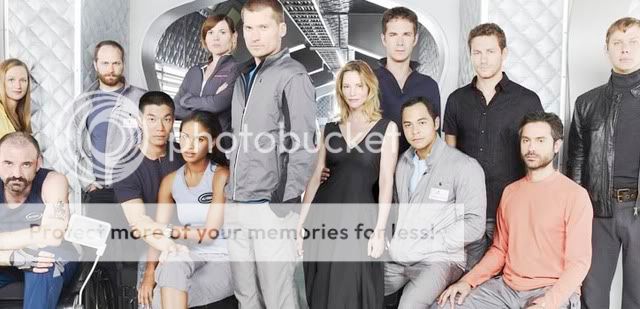
The cast of Virtuality. Image © 20th Century Fox 2009.
From Battlestar Galactica creator Ronald D. Moore and writer Michael Taylor comes an exciting new science fiction thriller, the two-hour special TV movie event Virtuality. “Our goal was to tell a story outwardly very different from Battlestar Galactica,” Moore explains, “but similar in its intent to explore the human character in an extreme setting.” In this case, the extreme setting is the outer border of previously explored space aboard the modern, self-sustaining spacecraft Phaeton. Helmed by intrepid, determined Captain Frank Pike (Nikolaj Coster-Waldau), the original goal was a 5 year exploratory mission to look for intelligent life beyond Earth. Early into their mission, however, the 12-person crew learns that due to the catastrophic effects of environmental ravages and global warming, Earth will become completely uninhabitable in 100 years. They are humanity’s last hope to seek out another planet deep in the cosmos capable of supporting life. A perilous slingshot around Neptune will lengthen the mission to 10 years, and propel Phaeton towards the distant star Epsilon Eridani in search of a new home. But as the ship nears the point of no return, the crew must decide whether to retreat home to Earth or thrust deeper into outer space, and the unknown, to answer the ultimate question: go or no go?
Psychological impacts of long-term missions in constrained environments have been limited to two years or less. To assuage the crew emotionally during their extended mission, and to provide the only source of privacy aboard Phaeton, they are provided with virtual reality head modules, with which they may realize any fantasy or simulated environment. Some people become rock stars, climb the Himalayas, enact Civil War battles; others recreate the family they left behind on Earth. But the technology remains imperfect, unexplored, especially in relation to the human mind. Present throughout the virtual worlds is a malfeasant, mysterious green eyed man (Jimmi Simpson), whose existence and motivations remain unclear. Does the avatar represent a virus, the inner conflict of each individual’s sublimated psyche, or a sabotage of the mission by a larger force? No one is certain. The presence of this escapist alternative universe, and the turmoil experienced therein by the crew of 12, raises important psychological and technological quandaries. What is real? A virtual “affair” between Captain Pike and a married crew botanist (Sienna Guillory)? A virtual rape? Virtual mental torture, whether self-imposed or at the hands of the green-eyed man? Says Moore, “It’s in this nexus of reality and “virtuality” where our characters’ shared and private worlds collide that we intended to find the drama of the show.”
Indeed, Virtuality bears several trademark Ronald D. Moore stamps: great science, terrific characters, and humanity-driven conflict and desperation. While Battlestar Galactica’s primary science angle focused on Cylon artificial intelligence, in Virtuality, astrophysics, geology and astrobiology take center stage. Especially pertinent amidst NASA’s recent exploratory missions, the Phaeton module employs top of the line physics to propel itself to far reaches of outer space, while self-contained greenhouses and laboratories analyze evolutionary life origins and biological compositions of space. Colorful characters abound on the Phaeton crew, including lead navigator/designer with a painful past Jules Braun (Erik Jensen), aggressive, self-destructive pilot Sue Parsons (Clea DuVall), paraplegic, self-doubting co-pilot Jimmy Johnson (Richie Coster), gay couple Val Orlovsky (Gene Farber) and Manny Rodriguez (Jose Pablo Cantillo) providing an infusion of hope and optimism, and married astrobiologists Kenji Yamamoto (Nelson Lee) and Alice Thibadeau (Joy Bryant) debating the pros and cons of raising a child aboard the confined ship. Compounding the stress and importance of Phaeton’s mission are your basic everyday problems: the ship’s only doctor (Omar Metwally) has Parkinson’s Disease, there aren’t enough medical supplies to sustain a ten-year mission, an escalating conflict of personalities and strategies between Captain Pike and his co-pilot, and the rampant obliteration of Earth by natural disasters. As he did in Battlestar, Moore does an exemplary job of using the scientific questions of our time as a platform to probe deeper into the meaning of life, humanity, and the ethical limits of an imminent fight for survival.
The most attractive aspect of Virtuality is how hip, modern and current it feels. With sleek, bright sets, fast-paced camera action from director Pete Berg, and gorgeous computer generated imaging of outer space and the virtual reality scenes, the show departs visually from the austerity that is often a sci-fi staple. It is also a shrewd, tongue-in-cheek satire about our obsession with “celebrity” against the backdrop of an all too plausible environmental reality here on Earth. The action aboard the Phaeton is being broadcast back on Earth as the most popular reality show of all time, “The Edge of Never,” being seen by billions every week. Orchestrated by Dr. Roger Fallon (James D’Arcy), whose simultaneous roles as reality show producer and on-board psychologist come into conflict, the show combines the drama of Earth’s impending doom and the search for other habitable planets with our modern televised voyeurism. Hosted by the well-meaning but invasive Billie Kashmiri (Kerry Bishé), the show meticulously follows every facet of the crew’s quotidian existence, complete with ubiquitous cameras throughout the ship, Big Brother-style confessional rooms, and manufactured conflict to entertain the masses. Combining Star Trek and The Hills, Virtuality adds yet another layer to the confounding question of what is real, what is virtual, and where the twain shall meet. All of this action and philosophy culminates in a shocking surprise twist that you will never see coming. It will test the sense of trust and camaraderie aboard the vessel, raise questions about the boundaries of escapism in a virtual world, and put in danger the crew’s psychological capacity for their ten-year mission in outer space.
As wonderful and suspenseful of a setup as the Virtuality pilotTV movie is, it does not necessarily augur well for its prospects of a series pick-up. It was not announced as a part of Fox’s upcoming fall schedule (a schedule brimming with scientific content such as Fringe, Dollhouse, Bones, House and Lie to Me), but Ronald D. Moore has not ruled out the possibility, saying that “Fox executives have never said “It’s over”” and that the two-hour movie had always been designed as a pilot. Nevertheless, despite their long history of fascination with science fiction, FOX has also managed to prematurely cancel some of its brightest gems in the genre, including Space Above and Beyond, Wonderfalls, and Firefly. So if you are passionate about Ronald D. Moore’s shows, and the presence of sophisticated, complex sci-fi that explores important existential questions, watch Virtuality on Friday night, and then get vociferious and get involved. Never underestimate the power of bloggers and fans to effect change. At last year’s Comic-Con, I personally witnessed the inception of pre-emptive petitions to rescue Dollhouse, which had not even aired a single episode. The result? It’s been renewed for a second season. If you like the show, write to FOX. Who knows? You could help turn Virtuality into a reality.
The Virtuality 2-hour movie premieres this Friday night, June 26th, at 8 PM ET/PT on FOX.
Incidentally, coming in July, we will be interviewing Dr. Kevin Grazier, the brilliant physicist who has acted as science advisor on Virtuality, Battlestar Galactica, and Eureka as a part of our celebration of the release of the BSG series box set and Comic-Con 2009. Stay tuned!
~*ScriptPhD*~
MOVIE REVIEW: The Last Beekeeper
Jun2
“The Last Beekeeper”
ScriptPhD Grade: A

The Last Beekeeper, a World of Wonder production.
A compelling, socially and scientifically significant new film is buzzing its way into the 2009 Los Angeles Film Festival. From director Jeremy Simmons, The Last Beekeeper is a stirring new documentary that explores the ramifications of Colony Collapse Disorder (CCD), the mysterious HIV-like pandemic killing bees en masse, on beekeepers, the pollination industry, and our ecosystem. The filmmakers follow the lives of three beekeepers over the course of a year, as they prepare and transport their bees to California’s massive annual almond pollination, an event that requires the assembly of nearly all American bees. In depicting their struggles, triumphs, and personal pain, the film delves into the scientific mystery behind CCD, the personal relationship that bonds an apiarist to their bees, and the lengths of devotion three human beings take to save themselves and an insect in crisis.
Nicole Ulibarri might have had a very different calling in life. Described by her family as smart and ambitious, Nicole got a college education and became a Seattle career woman. But she also comes from several generations of beekeepers, and the calling, along with anguish over a painful family loss, led her heart back to Montana, where she became a beekeeper. Eric Mills is probably the most interesting Southern-to-the-core gay beekeeper you’ll ever meet. Meticulous, obsessed, at times arrogant, and profoundly gifted at his profession, Eric sums up his philosophy: “If you take care of the bees, they will take care of you.” Matt Hutchins is the archetype of many blue-collar, self-made small business owners in America. His struggling rural Washington business has been decimated by dying bees, but Matt’s perseverance, sense of obligation, and love of his craft drives his desire to keep going. In 1996, the almond industry got a huge boost when California led research efforts on the health effects of almonds, leading to a doubling of almond consumption worldwide. California is the industry leader in almond production, growing 80% of the world’s supply. The caveat is that almonds are almost completely reliant on bee populations for pollination. As such, the yearly California crop acts as a sort of beekeeper’s “Yukon gold rush”. 75% of all American beekeepers head out to California yearly to pollinate almonds, and rely on this event to earn most of their income (approximately $150 for a full hive). Among them are Nicole, Eric and Matt. Would their hives survive the stressful voyage to California? Could they beat the unbelievable odds against them to make a year’s worth of work pay off?
What is Colony Collapse Disorder? Beginning in October 2006, some beekeepers began reporting losses of 30-90 percent of their hives. In 2007, 20 billion bees disappeared. This phenomenon, for which scientists have not been able to elucidate a cause, has been termed “Colony Collapse Disorder”. The main symptom of CCD is simply no or a low number of adult honey bees present but with a live queen and no dead honey bees in the hive. In a 2007 report prepared for Congress by the National Academy of Sciences National Research Council’s (NRC) “Status of Pollinators Committee”, several factors were isolated as contributing to CCD, including invasive parasitic varroa mites, introduction of Africanized honeybees to replace dying European colonies, resistance to antibiotics treating American foulbrood, the major bacterial disease affecting honey bees, poor nutrition, the small hive beetle, the use of insecticides in crop protection and the stress inflicted on dwindling US hives in almond pollination. In response to this crisis, the Agricultural Research Service arm of the US Department of Agriculture has released an action plan to mitigate honeybee losses from CCD. Heavily featured in The Last Beekeeper, Professor Dennis vanEngelsdorp and his group at the University of Pennsylvania are attempting to figure out the exact reasons bees are dying in droves. After conducting autopsies on thousands of dead bees, the sick bees were found to be bigger, darker, with alarming multi-disease abnormalities, indicating a systemic immunity collapse akin to HIV infection. Incidentally, for one of the best explanations of CCD and celebrations of beekeepers, check out this video TED Talk entitled “Where Have All The Bees Gone?” presented by Professor vanEngelsdorp, in which he delves into the gentle, misunderstood creature’s important place in nature and the mystery behind its alarming disappearance:
Beekeeping is an essential component of modern agriculture, providing pollination services for over 90 commercial crops grown in the United States. The honey bee adds $15 billion in value to agricultural crops each year, and the demand for honey bees is growing. The California almond crop alone uses 1.3 million colonies of bees for pollination, approximately one half of all honey bees in the United States.
Several important running themes are explored throughout this movie, with disappearing bees as the background context. Loss and devotion at all costs. Through all three stories told runs a profound sense of loss (whether Nicole’s personal tragedy or Matt’s hive devastation) and the cost of being a modern beekeeper. Matt’s decisions cause tremendous strife within his family, while Eric, whose partner quit his job to assist him with the business, sees himself as fungible compared to the bees. Bees as humanlike creatures. Through some very adroit camera work, Simmons is able to provide a rare emotional purview into the world of bees helping one another, working together, dying together. Above all else is the love of the bees. The beekeepers portrayed in this film make tremendous sacrifices, professionally and personally, but are motivated and driven because of a core love for the bees. At times gut wrenching, The Last Beekeeper effectively communicates the frustration and helplessness these caretakers feel.
If the current situation does not improve, the future for beekeepers looks pretty grim. As it stands, there are less than 1,600 beekeepers in all of the United States. (In 1950, there were 500,000.) At the rate they are dying, bees will cease to exist in North America by 2035. It is up to scientists, environmental activists, and ordinary citizens to take action, get informed, and prevent these assiduous, necessary, beautiful creatures from disappearing from our planet. At the end of the movie, sitting in his nearly devastated, ghostly apiary, beekeeper Jim Robertson sadly muses how much honeybees serve by nature. They make enough honey for themselves and everyone else, but we are constantly trying to get more out of them than they can give us. “It’s foolishness,” he remarks quietly. Foolishness, indeed.
The Last Beekeeper is a World of Wonder film, directed by Jeremy Simmons and produced by Fenton Bailey and Randy Barbato. It premiered at the SXSW Film Festival on March 14th, 2009. It is an official selection of the 2009 Los Angeles Film Festival, and has two screenings: Saturday, June 20, at 2:30PM at the Regent Theater (already passed), and on Thursday, June 25, at 4:45PM at the Landmark 4.
ScriptPhD.com had the opportunity to talk with Jeremy Simmons and Fenton Bailey and get their in-depth thoughts on the film and the beekeepers. For a transcript of our interview, please click “continue reading”.
TV REVIEW: Nurses Ratchet Up the Medical Show Ladder
Jun2
Suddenly, in the world of TV medicine, RN are the letters you want after your name. Two summer cable shows garnering considerable buzz, SHOWTIME’s Nurse Jackie and TNT’s HawthoRNe, shine the spotlight on nurses, the hospital heroes often relegated into the shadows of doctors on prime time. ScriptPhD.com got a sneak peak of the HawthoRNe pilot and the first half of the Nurse Jackie season.
Nurse Jackie (SHOWTIME)
ScriptPhD Grade: A
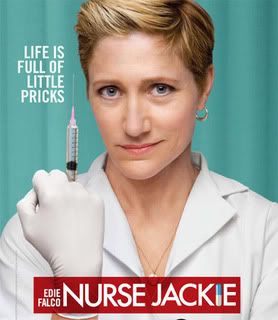
"This job is wading through a sh*tstorm of people who come in here on the worst day of their lives. Doctors are here to diagnose, not heal. We heal." Nurse Jackie photo © SHOWTIME and Lionsgate.
I didn’t want to love Nurse Jackie, I just want to say that for the record. First of all, she’s been taunting me on the billboards of Los Angeles all spring and summer long with that intimidating needle. Secondly, I didn’t know if I had it in me to get attached to yet another medical show. Third, after hooking me with brilliant shows like Dexter, Weeds and newcomer The United States of Tara, could SHOWTIME extend their magic touch to this newest addition to their franchise? They could, they did, and the result is some of the freshest television this side of basic cable. Starring three-time Emmy®-winner Edie Falco, Nurse Jackie is based on the provocative tell-all journal of a real-life Manhattan nurse. Shot on location in New York City, the show spares nothing in projecting the goings-on of a big-city ER through the eyes of one very unorthodox nurse.
And Jackie Peyton is certainly not an easy character to love. She’s decidedly cantankerous and has little time for people or their stupidities. “I don’t do chatty,” she barks. “I like quiet. Quiet and mean. Those are my people.” She’s got an unhealthy attachment to painkillers. No matter the delivery system (mouth, nose, coffee) or the type (Adderall, Vicodin, OxyContin, Percocet), Jackie’s not very picky. She views rules as bendable at best, nonexistent at worst. Oh yeah, and then there’s the part where she’s cheating on her husband. But there’s two sides to every coin, and Jackie is no exception. At home, he’s a devoted wife and mother. Her picture-perfect husband Kevin (Dominic Fumusa) struggles between tending to their daughters Grace, sporting an escalating emotional anxiety disorder, and Fiona (Ruby Jerins and Daisy Tahan) and running his bar. At the ironically named All-Saints Hospital, she’s an extraordinary, deeply empathetic nurse. Whether she’s helping a 10-year-old take care of her mom with some contraband pharmacy supplies, assisting a terminally ill fellow nurse, helping a mute stroke victim shut up his obnoxious family or stealing money from a criminal to help a dead patient’s poor fiance, Jackie weaves through the murky moral grey area to ultimately do what’s right for her patients. Part saint, part sinner, Nurse Jackie is never less than totally compelling.
Trailing Jackie’s every move (much to her dismay) is overly earnest, perky nursing student Zoey Barkow (Merritt Weaver). Luckily, Jackie can take reprieve from her besotted young acolyte and her problems with the rest of her hospital family. Providing cover is her partner in crime, fellow nurse Mohammed “Mo-Mo” de la Cruz (Haaz Sleiman), with whom she bends the rules, shares coffee breaks and romantic advice. Providing narcotics and lunchtime quickies is pharmacist Eddie Walzer (Paul Schulze). Her best friend and confidante is the wry Brit Dr. Eleanor O’Hara (a razor-sharp Eve Best). She has a penchant for expensive clothes, snappy comebacks and mid-town lunchcapades with “Jacks”, but seems to be holding back a painful past. Peter Facinelli (Damages) is the handsome, young Dr. Fitch “Coop” Cooper, who could easily be dismissed as a one-dimensional, book smart but inept playboy. But with lesbian moms (the devine Blythe Danner and Swoozie Kurtz), a proclivity for Tourette’s-like inappropriate touching, and better doctor skills than he gives himself credit for, Coop is more than meets the eye. Rounding out the ensemle is rote ER administrator Gloria Akalitus (The West Wing’s Anna Deveare Smith), who rules with an iron fist, thinking she’s hip to every trick in the book. (By the way, who knew Deveare Smith had such a gift for physical comedy? Two gags with a Taser and some wayward painkillers had me rolling on the floor.)
Employing top-notch writing and directing, led by creative team Evan Dunsky, Liz Brixius and Linda Wallem, Nurse Jackie shies away from tired old medical show tropes to peel back the layers of a functional addict leading compartmentalized lives, to realistically show the challenges nurses face in saving lives under the limitations of our broken medical system, and to ask, “What does it really mean to be good?” Nurse Jackie may be addicted to bad behavior and every painkiller on the planet, but in the end, I’m addicted to her. I wouldn’t have it any other way.
Nurse Jackie airs on SHOWTIME Mondays at 10:30 EST/PT, following Weeds.
HawthoRNe (TNT)
ScriptPhD Grade: B

The cast of HawthoRNe. Image © Turner Broadcasting, 2009.
A number of high-profile film actors have recently settled comfortably in starring TV roles, most successfully Emmy® winners Glenn Close (Damages) and Alec Baldwin (30 Rock). TNT, with their long and storied tradition of strong female drama leads, from Kyra Sedgwick’s The Closer to Holly Hunter’s Saving Grace, extends the same small-screen opportunity to Jada Pinkett Smith, who stars in new medical drama HawthoRNe. Lest there be any doubt about the girl power behind this series, it is being co-produced by Pinkett Smith’s 100% Womon [sic] Productions. In the first five minutes alone, Christina Hawthorne races to Richmond Trinity Hospital in the middle of the night, out(wo)mans an armed security guard, tends to a wandering psych ward patient, pays care to a homeless woman she’s befriended and talks down a suicidal cancer patient. But it turns out, there are some cracks in Christina’s impenetrable armor. For one, the pilot takes place on the one-year anniversary of the death of her husband, whose ashes she still talks to. To celebrate, her rebellious, headstrong daughter Camille (Hannah Hodson) chains herself to the school’s vending machine, much to her mother’s consternation. And a deliciously saccharine Joanna Cassidy is the still-meddling mother-in-law who also serves on Trinity’s board.
As the hospitals Chief Nursing Officer, Christina is organized, uncompromising, decisive, empathetic, and always puts the needs of patients first. Her charges include nurse Bobbie Jackson (Suleka Matthew), one of her best friends and nurse Ray Stein (David Julian Hirsh), a man caught in a woman’s world. Alias’s Michael Vartan (welcome back to television Mr. Vaughn!) is Dr. Tom Wakefield, the Chief of Surgery with whom Christina often butts heads administratively, but who also treated her late husband for cancer.
Still working out its kinks, HawthoRNe feels a bit uneven at times, mostly due to relying on some trite, atavistic medical formulas that come off stale. A genuinely compelling storyline about a homeless woman besieged with mental problems giving birth outside the hospital is negated by an unnecessary (and gross!) side plot involving a grateful nurse (Christina Moore)…um…thanking a wounded soldier for his service. Her name is Candy. Seriously. And a chance to explore doctor-nurse synergy and conflict in providing effective patient care turns downright silly when the characters in question ride two extremes: the stupendously arrogant, omniscient doctor whose decisions Cannot. Be. Questioned. and the equally timorous nurse who dare not think independently. And don’t forget to save some snickers, because he’s a male nurse, which is funny, or was in 1975.
TNT may know drama, but HawthoRNe needs to tone it down a bit. To be fair, having only viewed the pilot, the show has definite potential to grow. With the departure of ER, no current medical show centerpieces medicine in a cash-strapped, blue-collar city hospital. Set in Richmond, VA, HawthoRNe has a unique opportunity to tell stories pertaining to the challenges of its setting and patient population. It also is clearly a character-driven drama, establishing some fascinating early relationships. The tension between Christina and her bitchy mother-in-law, tempered by working through the shared grief with her still-angry daughter, makes for a rather interesting family triangle. And sparks fly between Pinkett Smith and Vartan, who is obviously being set up as a potential love interest. But the biggest asset is Pinket Smith herself. She brings an intensity, compassion and resolve to a complex character. Her movie star power translates well to the small screen, and could easily make HawthoRNe a fine vehicle for her considerable acting chops. Assuming they steer clear of Clicheland.
HawthoRNe premieres this Tuesday, June 16th on TNT at 9 EST/PT.
This sudden focus on the nursing profession doesn’t come a minute too soon. According to the American Association of Colleges of Nursing, the United States is in the midst of an imminent nursing shortage, compounded by the rapidly aging baby boomer population and low enrollment in nursing programs that is not expected to meet this demand. As of July, 2007, total RN vacancies across the US totaled 135,000, or 8.1%, according to a report released by the American Hospital Association. Projections from the U.S. Bureau of Labor Statistics published in the November 2007 Monthly Labor Review foresee that more than one million new and replacement nurses will be needed by 2016. Contributing factors vary, from a shortage of nursing school faculty and projected enrollments, to a slowing rate of growth for the overall nursing population, resulting in a climbing average age of the nursing population. The result for nurses? Insufficient staffing is raising their stress levels, impacting job satisfaction, and driving many nurses to leave the profession. The result for patients? Inadequate access to quality health care. An eye-opening report released in August 2002 by the Joint Commission on Accreditation of Healthcare Organizations, revealed that a shortage of nurses in America’s hospitals is putting patient lives in danger. JCAHO examined 1609 hospital reports of patient deaths and injuries since 1996 and found that low nursing staff levels were a contributing factor in 24% of the cases.
Less than a month ago, members of major nursing unions that included the California Nurses Association/National Nurses Organizing Committee, the United American Nurses (UAN), and the Massachusetts Nurses Association, congregated on Capitol Hill as part of a National RN Day of Action in Washington, D.C., that included a conference focused on promoting legislation that would guarantee certain ratios of nurses to patients nationally, a march and rally, and visits to their congressional representatives to advocate on various legislative issues. The legislation, House Resolution 2273, also seeks to protect the rights of nurses to advocate on behalf of their patients, and to invest in training new nurses to address the current nationwide nursing shortage.
To discuss some of these issues, and to get a dose of real-life perspective on the profession, ScriptPhD.com sat down with Dr. Suzette Cardin, Assistant Dean of Student Affairs at UCLA’s venerable School of Nursing, ranked in the top ten of national nursing programs. Dr. Cardin has over 35 years of experience in nursing, and prior to her faculty appointment, she spent 14 years as Unit Director of the Critical Care Unit and the Cardiac Observation Unit at the UCLA Medical Center. She has been honored as a Fellow of the American Academy of Nursing and the American Heart Association. To read our interview, please click “continue reading”.
Hi-Fi Sci-Fi: Battlestar Galactica: Cyborgs on the Horizon
Jun3
I’m honored to be joining ScriptPhD.com as an East Coast Correspondent, and look forward to bringing you coverage from events in such exciting areas as Atlanta, Baltimore, and New York City – as well as my hometown of Washington, DC.
And to that end, here is a re-cap of the World Science Festival’s panel “Battlestar Galactica: Cyborgs on the Horizon.” For anyone interested in the intersection of Science and Pop Culture, I cannot promote this event enough. In addition to the panel I’ll be describing, some of the participants included Alan Alda, Glenn Close, Bobby McFerrin, YoYo Ma, and Christine Baranski from the entertainment sector. Representing science were notables like Dr. James Watson (who along with Francis Crick was the first to elucidate the helical structure of DNA), Sir Paul Nurse (Nobel Laureate and president of Rockefeller University), and E.O. Wilson (who is celebrating his 80th birthday in conjunction with the festival).
However, it’s time to return to the subject of this post – BSG and Cyborgs. To read more about the discussion at the intersection of science fact and science fiction, please click “Continue Reading”.
Profile: Jorge Cham, Author of PHD Comics
Jun0
Piled Higher and Deeper
To people who might wonder what three most important factors helped me navigate the rigors of higher education, I’d say passion, persistence, and good old-fashioned hard work. Yeah, right! More like coffee, my iPod and PHD Comics. Oh yes, three times a week, as I’d saunter to my graduate mausoleumoffice, serious decisions had to be weighed: pipette smelly bacteria or laugh along to a spot-on comic strip spoofing the ups and downs of all things academe? You know I made the right choice every time!
What is PHD Comics? Its official name, Piled Higher and Deeper, is derived from one the oldest inside puns about ascension on the ladder of knowledge: if a BS stands for bullshit (pardon my Swahili), MS means more of the same, and attaining a PhD means you’re piled higher and deeper. (Empirical observations have validated the veracity of these acronyms.) Often relegated to fringe sidelines in media and popular culture, the junior Ivory Tower set is composed of a bustling microcosm sporting its own culture, mores, axioms, and idiosyncrasies. Illustrated and composed by scientist Jorge Cham, PHD Comics celebrates, spoofs, but most importantly, spotlights, this world with remarkable humor and authenticity. I have had too many “Oh my gosh that is SO true!” moments reading this comic to count. But a few notables:
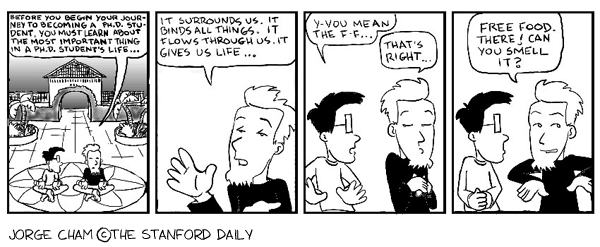
Graduate students’ love of free food, so true, so desperate, so universal.
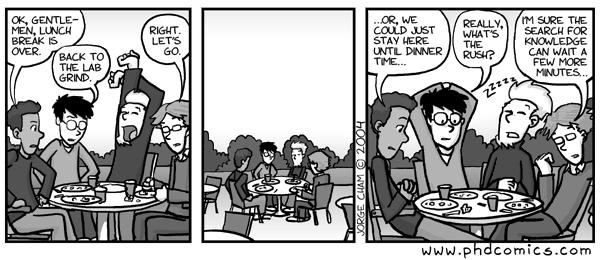
Ennui of the daily research grind (psst inside secret: yes, sometimes the days are very boring and graduate students waste time)

Frustrations with nonresponsive graduate “advisors” (we’ve all worked for or encountered a Professor “Smith”).
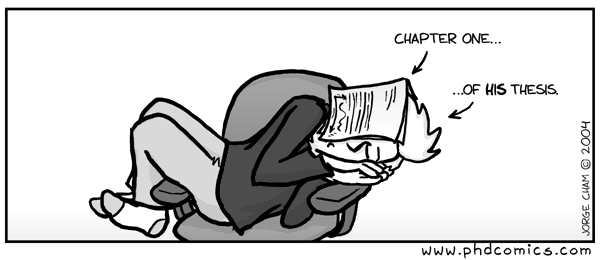
The writing of the thesis (basically the bane of any graduate student’s existence).
Jorge Cham got his undergraduate degree at Georgia Tech University He then completed doctoral studies in mechanical engineering at Stanford University with a research focus in Robotics. Jorge built robots that mimic natural biological functions in their technological design, resulting in some of the fastest running prototypes ever created. He also completed a postdoctoral fellowship at Caltech University, where his research specialized in the design of “smart” biomimetic neural implants. His impressive body of work includes 24 scholarly articles, invited talks at prestigious universities and leading corporations, as well as teaching experience as a lecturer at Caltech. Oh, yeah, and he can draw pretty well too!
PHD Comics embodies the notion of a mighty tree growing from a small acorn. Initially published as a black and white strip at the Stanford University Daily while Cham was a PhD student, it quickly built a devoted cult following. Especially popular among grad students, scientists, engineers and other tech-geeks, the strip eventually found its way into a plethora of college dailies and mainstream national publications, with the official site generating over 12 million monthly pageviews. To date, the comic has evolved into a full color publication, including posters, song parodies, and book collections that have sold over 60,000 copies. You can (and absolutely should!) catch the latest PHD Comics on the official website, follow along on Twitter or on Facebook.
A couple of standout hits hand-picked by the ScriptPhD:
“Who Will Grade Your Work?”, a song parody of Jewel’s “Who Will Save Your Soul?” (particularly appreciated by those of us who have had the…er…distinct pleasure of being Teaching Assistants). Click the link for the mp3.
“If TV Science Was More Like Real Science….” This strip was my favorite, and particularly apropos for our site, because we do cover the very best of science and technology in entertainment. Sometimes it’s really hard to ignore the worst!
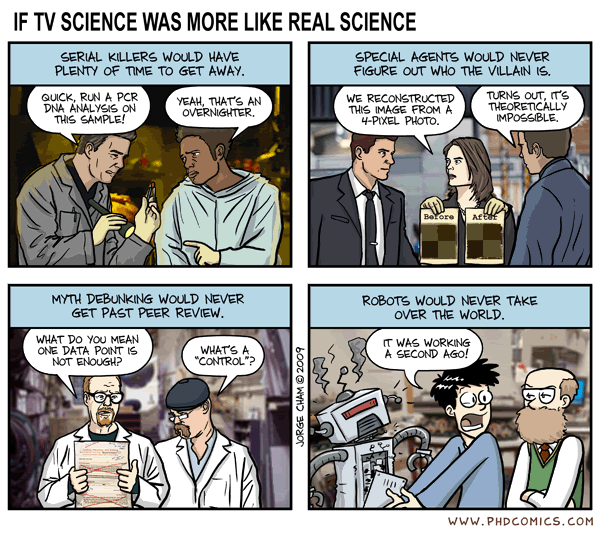
ScriptPhD.com was extraordinarily fortunate to catch up with Dr. Cham, who graciously and generously lent us some time in-between updating his strip and promoting the new addition to the PHD Comics books on a campus tour.
To read our exclusive interview with Jorge Cham, illustrator of PHD Comics, please click “continue reading”.
Hi-Fi Sci-Fi: I’m Gonna Take My Problem to the United Nations
Jun4
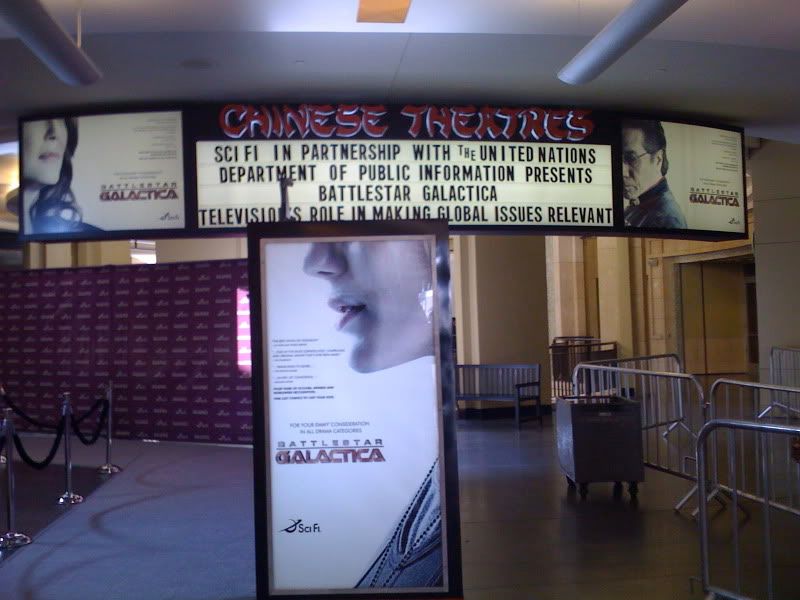
Remember back during our complete coverage of the Battlestar Galactica panel at the Paley Television Festival when I said that event would probably be the last significant gathering of on and off-screen talent from the show? Well, I may have been lyingpremature in my declaration. It’s no secret that in the annals of television history, Battlestar Galactica will rightfully take its place as one of the most sophisticated, abstruse, demanding, and thoughtful shows to ever grace the silver screen. No issue or hot-button topic was off-limits to the writers: war crimes, torture, genocide, abortion, religious conflict, human rights, the rule of law, anarchy, the very essence of humanness. Though an action-adventure space opera to its core, BSG integrated storylines eerily germane to the times we live in, and transcended its medium in the process.
In recognition of these tremendous achievements, and in a television first, the United Nations hosted an invitation-only panel back on March 17th in the hallowed Economic and Social Council Chamber composed of UN representatives and officers, cast members Mary McDonnell and Edward James Olmos, and executive producers Ronald D. Moore and David Eick. As a pilot project for its Department of Public Information’s Creative Community Outreach Initiative, the UN hopes to partner more often with the international film and television industries to raise awareness and foster discussion of prevalent global issues. Unfortunately the first United Nations event took place at their headquarters in New York and we had to miss it (sadly, the ScriptPhD is not yet bicoastal). But luckily for us, the United Nations partnered with the Sci-Fi Channel to host a West Coast rebroadcast from Hollywood Thursday night. As a part of the Los Angeles Times’s annual pre-Emmy Envelope Screening Series, LA Times writer Geoff Boucher moderated a panel that once again welcomed McDonnell, Olmos, Moore and Eick, and UN representatives Steven Siguero and Craig Mokhiber.
Amid a chorus of enthusiastic fans and “So say we all!”s, a lively and vibrant discussion ensued about torture, enemy combatants, race, and the upcoming Battlestar Galactica: The Plan TV movie event. ScriptPhD.com is proud to bring you complete coverage.
To read a transcript of the LA Times Envelope Battlestar Galactica Discussion Panel please click “Continue Reading”.
From the Lab: Breaking Bad, Chemistry Good
Jun12
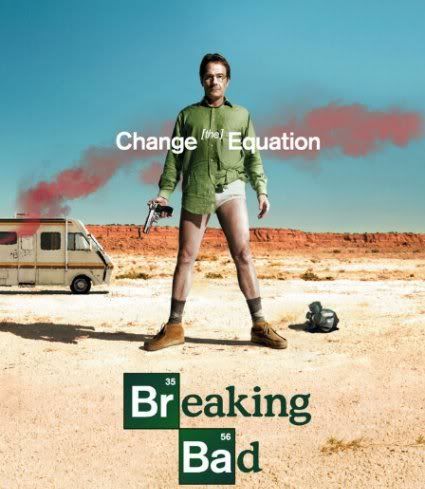 I must preface this next post with a little truth in advertising. I’m a chemist. True blue, to my very core. College degree in physical chemistry, PhD in chemistry. So when I heard about a cable show on AMC whose whole premise rested on a chemistry teacher manufacturing meth, I must say, I was slightly skeptical. The propensity for letdown was huge, both in plot and in science. Well, let me assure you that Breaking Bad broke good. A “Break”out hit in its second season, the show has managed to layer complex serialized storytelling with compelling characters and stories, and even better science. In fact, chemistry itself can very well be considered a recurring character on this show and we’ll highlight some of the best moments in a bit.
I must preface this next post with a little truth in advertising. I’m a chemist. True blue, to my very core. College degree in physical chemistry, PhD in chemistry. So when I heard about a cable show on AMC whose whole premise rested on a chemistry teacher manufacturing meth, I must say, I was slightly skeptical. The propensity for letdown was huge, both in plot and in science. Well, let me assure you that Breaking Bad broke good. A “Break”out hit in its second season, the show has managed to layer complex serialized storytelling with compelling characters and stories, and even better science. In fact, chemistry itself can very well be considered a recurring character on this show and we’ll highlight some of the best moments in a bit.
ScriptPhD Grade: A+
The Premise
If the pilot episode doesn’t get your attention in the first five minutes, then I don’t know what will. A man wearing nothing but his skivvies and a gas mask careens a Winnebago in the New Mexico desert, a passed out body beside him, two more dead in the back, and a toxic sludge of chemicals seeping on the floor. With impending sirens approaching, he videotapes a final goodbye and apology to his family. Through flashbacks, we come to find out that the man is Walter White, an unassuming chemistry teacher in Albuquerque, NM. While on his humiliating moonlighting shift as a car wash attendant, because we pay our public school teachers so well, Walt collapses. The culprit? Lung cancer. Terminal. Inoperable. He decides to infuse some excitement into his life on a bust ride with his brother-in-law, a DEA agent. Only instead of discouraging Walt, the bust shows him how much money can be made. While pondering the possibility of leaving his family financially secure after his passing, he spots an old flunky student, Jesse Pinkman, fleeing the scene. “You know the business, I know the chemistry,” he proposes to Jesse. An idea is born, and the metamorphosis of Walter White begins. Back to the original scene, the sirens turn out to be fire trucks, one of the many hair-raising escapes to come, and Walt and Jesse live to sell meth another day.
In addition to Walt (played by the talented Bryan Cranston), and Jesse (dazzling newcomer Aaron Paul), we meet Skyler (Anna Gunn), Walt’s supportive but perplexed wife, who grows to be very suspicious of him as he has a harder time curtailing his clandestine activities, and Walt, Jr., a teenager with Cerebral Palsy, sensitively portrayed by RJ Mitte. The relationships serve as a centerpiece of the show are unraveled like the plot, in layers and tantalizingly. As Walt’s own family unit faces turmoil, Jesse, too, is disowned by his for his drug use. What started out as a business transaction between a teacher and former student blossoms into a tender father-son relationship. Meanwhile, while Walt’s well-meaning DEA brother-in-law Hank (Dean Norris) closes in on the hottest new meth dealer in town, Walt and Jesse face a series of personal and professional setbacks. For every two steps forward, for every dollar made, there is a new foe, a new nemesis, or new unintended collateral. All of the action culminates in an electrifying Season 2 finale sure to generate buzz and anticipation for Season 3.
The Science
Science on Breaking Bad is given the red carpet treatment: it’s sleek, sexy, geek-chic, tongue-in-cheek and everywhere. The show revels in delightful touches such as the title credits interspersing elements from the periodic table. Walt’s classes brim with interesting blink-or-you-miss-it factoids, such as H. Tracy Hall inventing the first reproducible process for making diamonds. To a stupefied, gun-happy Jesse, he makes the suggestion of killing a drug lord with castor beans, the source of the protein toxin ricin. And let’s not mention the two separate synthetic methods he comes up with to cook and crystallize the best meth the New Mexico DEA has ever seen. The darkly comedic highlights of the show are Walt and Jesse’s interactions in their “laboratory”, a beaten-down Winnebago camper. Shocked by Jesse’s sloppy street cooking, Walt pilfers glassware and equipment from his classroom—gas masks, round bottom flasks, reflux condensers, crystallization dishes—to build a setup worthy of Pfizer. Along the way, Jesse gets some remedial chemistry that he failed back in high school. I mean, sure, they’re making a devastating and highly illegal narcotic, but at least it’s via a proper Grignard reagent amination of a Schiff base!
On a more serious note, Breaking Bad also strives for a VERY candid and unrelenting portrayal of both cancer and the ramifications of the modern-day drug trade. Often whitewashed in entertainment, Walt’s cancer, and the side effects are shown in a brutal way, but the stark realism also underscores his desperation as the illness unfolds. Easily on par with David Simon’s brilliant The Wire on HBO, in the world of Breaking Bad no one is absolved from the intertwining effects of drugs—the rising body count, both from use and dealing, the strain on law enforcement, and families torn apart. In an astute opening TRULY ripped from the headlines, a Season 2 Breaking Bad episode starts with an original narcocorrido, a Mexican drug ballad evolved from its folk music tradition that is often used to chronicle the drug trade and escalating violence over the last two decades. Take a look:
Bottom line: the science is white-hot, the writing is red-hot, the meth is blue and the humor is black, so why aren’t you watching?
Accolades
Breaking Bad has been the recipient of a number of recent awards and critical acclaim. They won a 2009 Peabody Award for excellence in television achievement. Bryan Cranston won the 2008 Emmy for Outstanding Leading Actor in a Dramatic Series. Series creator and executive producer Vince Gilligan won a Writers Guild of America award for the Pilot episode. Many more achievements are sure to come for their outstanding sophomore effort!
For the ScriptPhD.com Top 4 Walter White Chemistry Moments in the show thus far and an in-depth discussion of the neat science behind them, click “continue reading”…

















